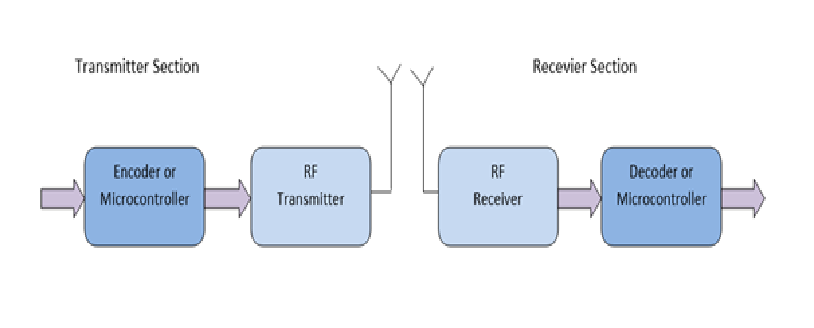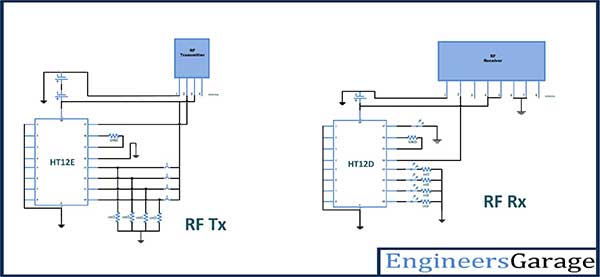434 MHz RF modules are commonly used in electronic projects. These modules can transmit data at a rate of 1 Kbps to 10 Kbps and send or receive data over a distance of 50 to 60 meters. The module already has an impressive operating range that is suitable for most DIY projects. However, some projects may require transmitting data over a greater range.
The range of an RF module can be increased by attaching appropriately sized antennas to the transmitting and receiving sections of the module or by increasing the transmit power of the module. Either or both methods can be implemented to extend the operational range of an RF module.
In this project, the effect of increasing transmit power on the operational range of the standard RF module was inspected. The basic RF transmitter and receiver configurations were built on breadboards and the range was tested by changing data transmission in outdoor environments. Range is predicted by measuring the exact distance between the receiver and transmitter sections using a tape measure.
Required components
| Mr. No. | Required components | Required quantity |
|---|---|---|
| 1 | RF Tx Module (434Mhz) | 1 |
| two | RF Rx Module (434 MHz) | 1 |
| 3 | HT12E | 1 |
| 4 | HT12D | 1 |
| 5 | LED | 5 |
| 6 | Resistor – 1KΩ (a quarter of a watt) | 8 |
| 7 | Resistor – 1MΩ (a quarter of a watt) | 1 |
| 8 | Resistor – 50KΩ (a quarter of a watt) | 1 |
| 9 | push button | 4 |
| 10 | Battery – 9V | two |
| 11 | Test board | two |
| 12 | Connecting wires | – |

BLOCK DIAGRAM
Circuit Connections
RF Module circuit connections are made as specified in the data sheets of the HT12E IC, HT12D IC, RF transmitter and RF receiver. These circuit connections are already explained in the Basic RF Transmitter and Receiver Experiment Model. To test the effect of increasing transmit power on an RF module operating range, the operating range is first observed with modules powered by a single 9V battery. Circuit connections are made and the circuits receive power through the 9V battery or portable 9V power supplies. The circuits are taken to an open location where the distance between the receiver and transmitter can be measured in a straight line using a tape measure. The address bits of the encoder and decoder ICs are connected to ground to set the address bytes of the transmitter as well as the receiver to 0x00.

The data bits in the encoder IC are also connected through switches to transmit 4-bit variable data. This data bit can be set anywhere between 0x1 and 0xF so that at least one LED on the receiver module lights up to indicate that the signal is being received correctly. Pin 14 of the encoder IC is connected to ground to facilitate uninterrupted transmission. Push-to-on switches are used on the data pins of the encoder IC so that the transmission bit can be changed with increasing distance. This is important because the data pins on the decoder IC are latch type and the data bit transmitted once remains on the data pins of the decoder IC until a new bit is received. Therefore, a data bit, once received at the decoder IC, remains persistent even if the receiving module stops receiving the radio signal. Therefore, to ensure that the radio signal is being received, the data bit must be changed every time the distance between the transmitter and receiver increases.
During the second phase of the experiment, the power supply for the transmitter and receiver modules is replaced from single 9V batteries to a series of two 9V batteries.
How the circuit works
First, the operating range of the RF module is tested with single 9V battery supplies. The transmitter and receiver are kept at a distance of 10 meters and a change in the transmit bit is made to test the reception of the radio signal at the receiver module. The bit has been changed successfully. The distance between the RF transmitter and the receiver is increased by 10 meters each time and the reception of the radio signal is tested by changing the data bit in the transmitter module. The RF 434 module successfully receives signals at a distance of between 60 and 70 meters. Beyond 70 meters, the radio signal disappears and the change in the transmitted bit is not reflected in the receiving module. For more accurate prediction, now above 60 meters, the distance is increased by 1 meter at a time and the reception of the changed data bits is tested. Therefore, the operational range of the 434 RF module with single 9V battery power is predicted to be 68 meters.

In the second phase, the transmitter and receiver sections are powered by two 9V batteries connected in series each. Connecting the batteries in series maintains the same current supplied to the circuits and antennas, but doubles the supply voltage to 18V. Due to the increase in supply voltage, the power transmission to the antennas increases and the operational range of the RF module also increases. In the second and final phase of the experiment, the operational range of the RF module increased to 102 meters.
| Power (Battery No.) – > | Single 9V battery | Two 9V batteries in series |
|---|---|---|
| Reach – > | 68 meters | 102 meters |
Project source code
Circuit diagrams
| Power-Based RF Range |  |

